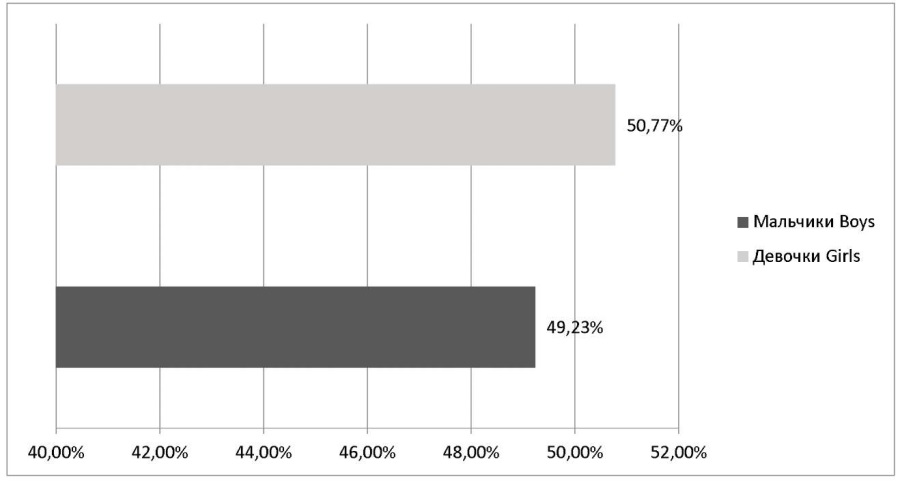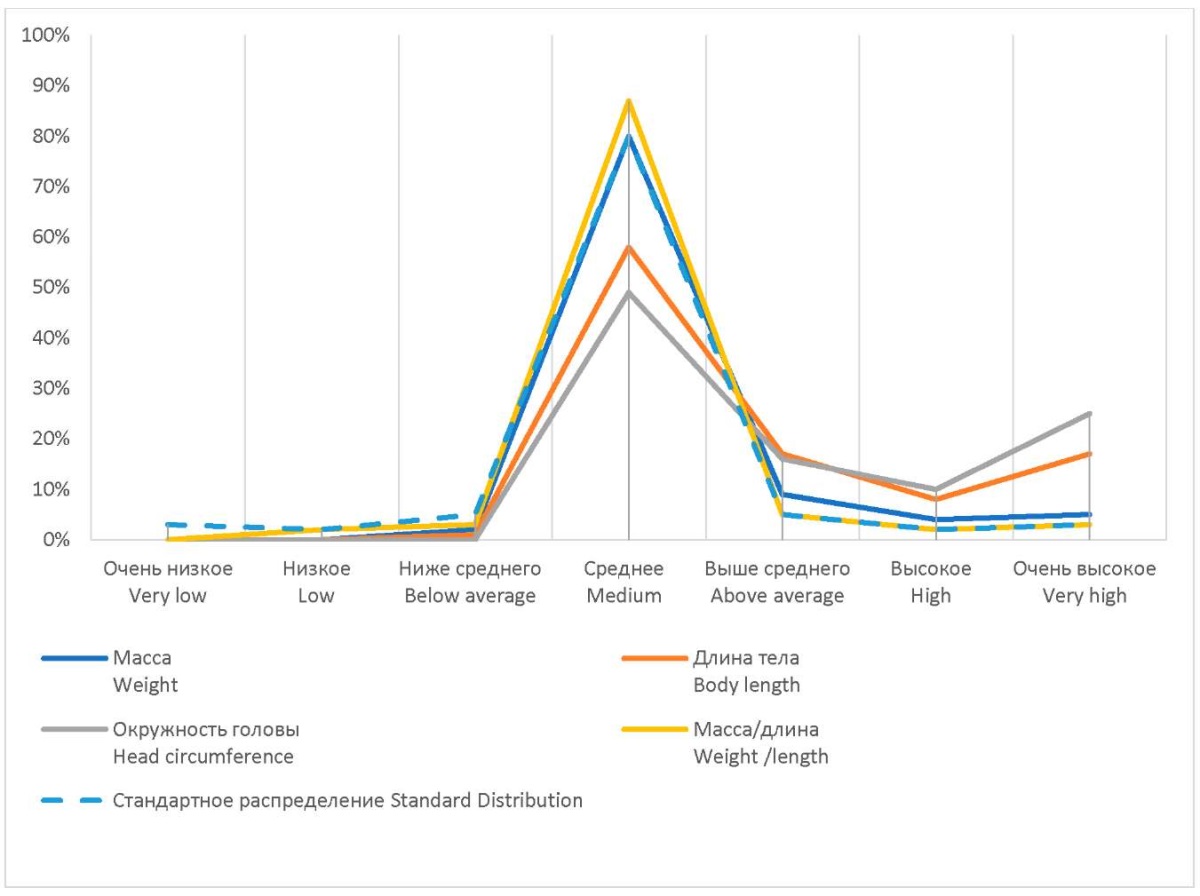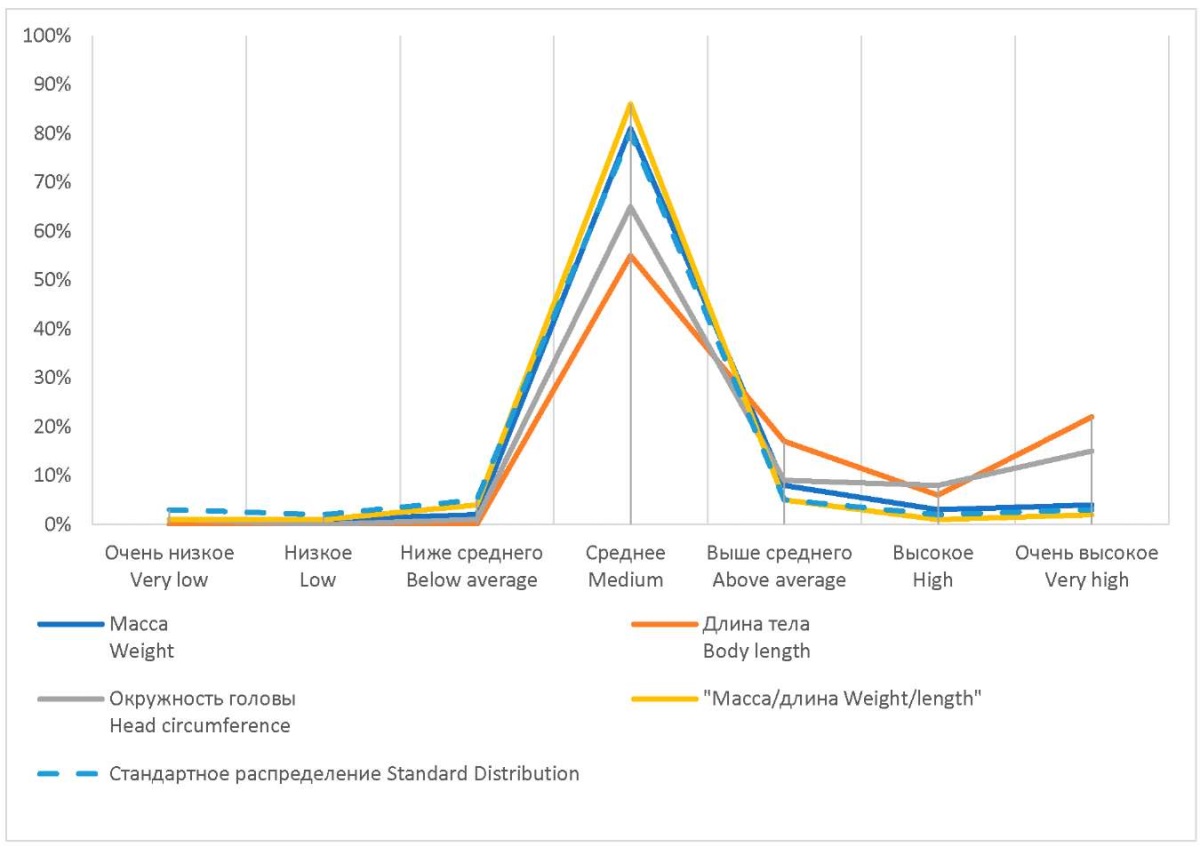Scroll to:
Assessment of physical development healthy full-term newborns of the Republic of Crimea centile standards INTERGROWTH-21st
https://doi.org/10.21886/2219-8075-2023-14-1-43-49
Abstract
Objective: to determine the feasibility of using INTERGROWTH-21st centile tables in assessing the physical development of full-term newborns in the Republic of Crimea.
Materials and methods: a retrospective analysis of 1300 birth histories of full-term newborns whose mothers permanently reside on the territory of the Republic of Crimea was carried out. Mass and length, chest and chest circumference were analyzed. The assessment of the obtained anthropometric indicators was carried out by the centile method according to the INTERGROWTH-21st tables. In the study, we conducted a comparative assessment using the accepted INTERGROWTH-21st standards, comparing them with the accepted domestic assessments of the state of the physical development of newborns.
Results: the values of anthropometric indicators of boys in the Republic of Crimea are shifted towards higher estimates. Estimates “below average”, “low”, “very low” are found in no more than 3% of cases. “Above average”, “high”, “very high” are much more common: with 10% — for weight/length ratio, 18% — for weight, 34% — for length, and 51% — for head circumference. The values of anthropometric indicators of girls in the Republic of Crimea are also biased towards higher estimates. Ratings of “below average”, “low”, “very low” are very rare: 6% — for the weight/length ratio, 4% — for the weight rating, less than 1% — for the body length rating and 2% — for the head circumference. “Above average”, “high”, “very high” scores are much more common: 8% — for weight/length ratio, 15% — for weight score, 45% — for length score, and 30%— for OH.
Conclusions: we consider the use of centile tables INTERGROWTH-21st in assessing the physical development of full-term newborns of the Republic of Kazakhstan to be inappropriate and we see the need to develop regional standards.
For citations:
Balakchina A.I., Kaladze N.N. Assessment of physical development healthy full-term newborns of the Republic of Crimea centile standards INTERGROWTH-21st. Medical Herald of the South of Russia. 2023;14(1):43-49. (In Russ.) https://doi.org/10.21886/2219-8075-2023-14-1-43-49
Introduction
Health is one of the indicators that most fully determines the specifics and structure of modern society. One of the main components of child population health, reflecting the influence of endo- and exogenous factors, is the physical development of children [1][2]. Assessment of the physical development of newborns is one of the main components in analyzing the state of their health [3–6]. Physicians in the Russian Federation use INTERGROWTH-21st centile tables when assessing the anthropometric indicators of newborns. However, when comparing the WHO standards with regional standards [3][7], it was proved that the WHO method was a certain benchmark showing how children can develop in optimal conditions without taking into account socioeconomic and other peculiarities, so the specified standard was not always optimal. Applying the same standards to all children regardless of their area of birth and residence may erroneously define their development as abnormal [8–9].
The aim of the study was to determine the feasibility of using INTERGROWTH-21st centile tables in assessing the physical development of mature newborns in the Republic of Crimea (RC).
Materials and Methods
The study was conducted on the basis of Simferopol Clinical Maternity Hospital No. 1. A retrospective analysis of medical records was carried out for 1300 delivery histories (form No. 096/u) of mature newborns whose mothers permanently resided in the territory of the RC. Body weight and length, head circumference (HC) and chest circumference (CC) of 1300 mature newborns (640 (49.23%) boys, 660 (50.77%) girls) were analyzed.
The inclusion criterion was healthy mature newborns, whose mothers were native residents of the RC.
The exclusion criteria were the gestational age of newborns less than 37 and over 42 weeks, Apgar score less than 8/8 points, congenital malformations, and permanent residence of mothers of newborns outside the RC.
The values of the main anthropometric indicators of physical development (body weight, body length, HC, CC) of mature newborns in the RC were determined.
The evaluation of the anthropometric parameters of newborns in the Republic of Crimea was carried out by the centile method according to INTERGROWTH-21st tables. When using this method, anthropometric data are determined by analyzing the percentage distribution of values of signs in the corresponding age-sex group of healthy children.
When assessing by the centile method, the measured value of length, body weight, or BMI was compared with the reference values presented in the INTERGROWTH-21st table for the corresponding sex and gestational age, and a centile corridor corresponding to the selected value was established.
The peculiarity of the assessment of anthropometric indicators of newborns according to the INTERGROWTH-21st centile tables is the difference in the INTERGROWTH-21st centile intervals (3%, 5%, 10%, 50%, 90%, 95%, 97%) and the accepted intervals in domestic practice (3%, 10%, 25%, 50%, 75%, 90%, 97%). Such gradation of evaluation indicators makes it difficult to compare with known methods and reduces the effectiveness of the application of international standards in Russia.
In this study, the authors conducted a comparative assessment using the accepted INTERGROWTH-21st standards, comparing them with the accepted domestic assessments of the state of physical development of newborns (Table 1).
Table 1
Assessment of the anthropometric indicators of newborns according to centile tables INTERGROWTH-21st
|
Assessment |
Centile standards in the Russian Federation |
Centile standards INTERGROWTH-21st |
|
Very high |
Over 97 centile |
Over 97 centile |
|
High |
90 to 97 centile |
90 to 97 centile |
|
Above average |
75 to 90 |
90 to 95 |
|
Average |
25 to 75 |
10 to 90 |
|
Below the average |
10 to 25 |
5 to 10 |
|
Low |
3 to 10 centile |
3 to 5 centile |
|
Very low |
Below 3 centile |
Below 3 centile |
Statistical processing was performed using the Microsoft Office Excel-2010 and STATISTICA-10 programs. Anthropometric data were analyzed by the method of variation statistics. The reliability of the difference between the signs was evaluated by Student's t-test. The data were considered significant at p<0.05.
Results
The gender composition of mature newborns in the RC is presented in Fig. 1, which shows that the ratio of boys (49.23%) to girls (50.77%) was not significantly different (p>0.05).

Fig. 1. The ratio of full-term newborns in the Republic of Crimea, depending on gender
The mean body weight of boys was 3523.62±426.86 g, and that of girls was 3368.73±417.99 g. The mean body length of boys was 51.54±1.82 cm, and that of girls was 50.85±1.80 cm. The mean HC of boys was 35.35±1.21 to 34.72±1.22 cm. The data of mean CC were as follows: in boys – 34.49±1.55 cm, in girls – 33.98±1.55 cm. The anthropometric data of boys were significantly greater (p<0.001) than the anthropometric characteristics of girls.
The results of anthropometric parameters of newborn boys (640), according to INTERGROWTH-21st centile tables, are shown in Table 2.
Table 2
Assessment of the anthropometric indicators of newborn boys in the RC according to centile tables INTERGROWTH-21st
|
Index |
Unit |
Very low (below 3) |
Low (3 to 5) |
Below average (5 to 10) |
Medium (from 10 to 90) |
Above average (90 to 95) |
High (95 to 97) |
Very high (above 97) |
|
Weight |
newborns |
2 |
1 |
14 |
509 |
57 |
23 |
34 |
|
% |
0% |
0% |
2% |
80% |
9% |
4% |
5% |
|
|
Body length |
newborns |
2 |
1 |
7 |
368 |
106 |
48 |
108 |
|
% |
0% |
0% |
1% |
58% |
17% |
8% |
17% |
|
|
Head circum-ference |
newborns |
0 |
0 |
1 |
316 |
100 |
61 |
162 |
|
% |
0% |
0% |
0% |
49% |
16% |
10% |
25% |
|
|
Weight / length |
newborns |
2 |
3 |
17 |
555 |
33 |
11 |
19 |
|
% |
0% |
0% |
3% |
87% |
5% |
2% |
3% |
Fig. 2 shows the distribution of anthropometric indices of newborn boys in the RC, according to the INTERGROWTH-21st centile tables.

Fig. 2. Distribution of estimates of anthropometric indicators
of newborn boys in the Republic of Crimea by assessment intervals
according to the INTERGROWTH-21st centile tables
The analysis of the results shows that the values of anthropometric indicators of newborn boys in the RC are shifted toward higher grades. Assessments "below average", "low", and "very low" occur in no more than 3% of cases. Above average, high, and very high scores are much more common: 10% for weight/length, 18% for weight, 34% for body length, and 51% for HC.
The results of anthropometric indicators of newborn girls (660) using the INTERGROWTH-21st centile tables are summarized in Table 3.
Table 3
Assessment of the anthropometric indicators of newborn girls in the RC according to centile tables INTERGROWTH-21st
|
Index |
Units |
Very low (below 3) |
Low (3 to 5) |
Below average (5 to 10) |
Medium (from 10 to 90) |
Above average (90 to 95) |
High (95 to 97) |
Very high (above 97) |
|
Weight |
newborns |
4 |
8 |
14 |
535 |
51 |
22 |
26 |
|
% |
1% |
1% |
2% |
81% |
8% |
3% |
4% |
|
|
Body length |
newborns |
2 |
2 |
1 |
362 |
110 |
40 |
143 |
|
% |
0% |
0% |
0% |
55% |
17% |
6% |
22% |
|
|
Head circum-ference |
newborns |
6 |
3 |
8 |
429 |
60 |
53 |
101 |
|
% |
1% |
0% |
1% |
65% |
9% |
8% |
15% |
|
|
Weight /length |
newborns |
8 |
6 |
27 |
568 |
30 |
6 |
15 |
|
% |
1% |
1% |
4% |
86% |
5% |
1% |
2% |
Fig. 3 shows the distribution of anthropometric indices of newborn girls in the RC according to the INTERGROWTH-21st centile tables.

Fig. 3. Distribution of estimates of anthropometric indicators
of newborn girls in the Republic of Crimea by assessment intervals
according to INTERGROWTH-21st centile tables
Analysis of the results shows that the values of anthropometric indicators of newborn girls in the RC are also shifted toward higher grades. The estimates "below average", "low", and "very low" are very rare: 6% for the mass/length ratio, 4% for mass, less than 1% for body length, and 2% for HC. "Above average", "high", and "very high" scores are much more common: 8% for the mass/length ratio, 15% for the mass score, 45% for the body length score, and 30% for HC.
Discussion
The results of the INTERGROWTH-21st centile tables for boys suggest that newborn boys in the RC have average scores for most indicators (weight – 80%, body length – 58%, HC – 49%, weight/length – 87%). The observed asymmetry of results with the prevalence of higher grades indicates a possible discrepancy between the INTERGROWTH-21st international standards and the regional peculiarities of the indicators of newborn boys of the RC and the living conditions of their mothers. The asymmetry is particularly pronounced for weight (16%), length (41%), and HC (51%). The slight asymmetry of the mass/length ratio, which amounted to 7%, indicates that this indicator is appropriate for the largest number of newborn boys in the RC, with an "average" score in 87% of cases. However, this high value also indicates that the choice of the 10–90% centile interval in the INTERGROWTH-21st methodology is inconvenient for analyzing the condition of newborns, which reduces the usefulness of this scale for practical application.
The results of the INTERGROWTH-21st centile tables for girls allow the authors to conclude that newborn girls in the RC have average scores for most indicators (weight – 81%, body length – 55%, HC – 65%, weight/length – 86%). The observed asymmetry of the results is similar for boys with a predominance of higher grades, indicating a possible discrepancy between the INTERGROWTH-21st international standards and the peculiarities of newborn girls in the RC and the living conditions of their mothers. The asymmetry was particularly pronounced for weight (11%), length (41%), and HC (30%). Newborn girls had higher values of body length and HC. The increase in mass indices was not so strongly pronounced. A slight asymmetry of the mass/length ratio, which amounted to 2%, indicates that the assessment of this indicator of newborn girls in the RC corresponds to the average values according to the INTERGROWTH-21st standard, the assessment "average" was given in 86% of cases. The high value indicates that the choice of the 10–90% centile interval in the INTERGROWTH-21st methodology is inconvenient for grading analysis, which reduces the usefulness of this scale for practical application.
Most Russian scientists [3][4][10] make a comparison with the centile tables of Mazurin and Vorontsov [11]. Zryachkin and Elizarova [10] note the inconsistency of the used centile scales of. Mazurin and Vorontsov for assessing the physical development of children living in the territory of the Engels municipal district of the Saratov Region. Maydannik and Yushchik [12], analyzing the physical development of newborn children in Kiev, showed that the average values of anthropometric indicators exceeded the average values of the corresponding anthropometric indicators in the WHO norms. No data on the assessment and analysis of the physical development of healthy preterm newborns in the RC in comparison with international standards were found in the scientific literature.
It can be assumed that the use of international standards for the assessment of anthropometric indicators of newborns in the RC without taking into account regional peculiarities may lead to incorrect assessments of the newborn’s condition, recommendations and choice of treatment tactics.
Conclusion
The use of INTERGROWTH-21st centile tables showed that the majority of newborns in the RC corresponded to average scores, with over 80% of newborns in the 10–90% corridor for weight and weight/length ratios. For body length and HC, there was a significant shift of scores to a corridor of higher values, indicating the need to adjust the standards when applied in the territory of the RC. The smallest deviation from INTERGROWTH-21st standards was observed for the mass/length indicator, but over 85% of newborns fell into the 10–90% interval, indicating that the INTERGROWTH-21st model intervals do not match the real distribution of mass/length indicator values in newborns in the RC.
Thus, the authors consider inappropriate the use of INTERGROWTH-21st centile tables in assessing the physical development of mature newborns in the RC and see the need to develop regional standards for newborns in the RC.
References
1. Baranov A.A., Shcheplyagina L.A. Basic and applied problems of pediatrics at the present stage. Russian pediatric journal. 2005;(3):4–8. (In Russ.) eLIBRARY ID: 17107739; EDN: OKJPBP
2. Balakchina A.I. Physical development and adaptive potential of healthy newborn children in the Crimean region. Materials of the All-Russian Scientific and Practical Conference «Science and Society». Autonomous non-profit organization of additional professional education «Siberian Institute of Practical Psychology, Pedagogy and Social Work», 2018;7-2:4-6. (In Russ.).
3. Kildiyarova R.R. Evaluation of physical development of newborns and children of early age. Rossiyskiy Vestnik Perinatologii i Pediatrii (Russian Bulletin of Perinatology and Pediatrics). 2017;62(6):62-68. (In Russ.). https://doi.org/10.21508/1027-4065-2017-62-6-62-68
4. Kildiyarova R.R. Assessing physical development of children with percentile diagrams. Current Pediatrics. 2017;16(5):431-437. (In Russ.). https://doi.org/10.15690/vsp.v16i5.1808
5. Baranov A.A., Kuchma V.R., eds. Physical development of children and adolescents of the Russian Federation. Moscow: Pediatr; 2013. (in Russ)
6. Baranov A.A., Kuchma V.R., Skoblina N.A. Physical development of children and adolescents at the turn of the decades. Moscow; 2008. (In Russ).
7. Zhdanova O.A. Comparative characteristics of physical developmental indices in children from the Voronezh Region in 1997–1999 and 2011–2014. Rossiyskiy Vestnik Perinatologii i Pediatrii (Russian Bulletin of Perinatology and Pediatrics). 2017;62(1):87-93. (In Russ.). https://doi.org/10.21508/1027-4065-2017-62-1-87-93
8. Kuzmichev Yu.G., Bogomolova E.S., Kalyuzhny E.A., Shaposhnikova M.V., Badeeva T.V., et al. Informational content of regional and international standards of evaluation of length and body mass of children and teenagers. Meditsinskiy al’manakh. 2015;(2):83-86. (In Russ.) eLIBRARY ID: 23488800; EDN: TUADLV
9. Kuchma V.R., Skoblina N.A. Evaluation comprehension of the children and adolescent physical growth in the course of the population research. Current pediatrics (Moscow). 2008;7(1):26–28. (In Russ.). eLIBRARY ID: 11531512; EDN: JSIYMX
10. Zryachkin N.I., Elizarova T.V. About the necessity of for regional standards of physical development of young children in the early age. Astrakhan medical journal. 2013;8(3):117-121. (In Russ.) eLIBRARY ID: 20462273; EDN: RFUEIZ
11. Mazurin A.M., Vorontsov I.M. Propedeutics of children’s diseases. St. Petersburg: Foliant; 2006. (in Russ)
12. Maidannyk V.G., Yuschik E.A. Information content of international standards in the evaluation of anthropometric indicators of newborn children in Kyiv. International Journal of Pediatrics, Obstetrics and Gynecology. 2013;3(2):14–18. (In Russ).
About the Authors
A. I. BalakchinaRussian Federation
Anna I. Balakchina, аssistant of the Department of Pediatrics with a Course of Children’s Infectious Diseases
Simferopol
Competing Interests:
The authors have no conflict of interests to declare.
N. N. Kaladze
Russian Federation
Nikolai N. Kaladze, Dr. Sci. (Med.), Professor, Head of the Department of Pediatrics, Physiotherapy and Balneology
Simferopol
Competing Interests:
The authors have no conflict of interests to declare.
Review
For citations:
Balakchina A.I., Kaladze N.N. Assessment of physical development healthy full-term newborns of the Republic of Crimea centile standards INTERGROWTH-21st. Medical Herald of the South of Russia. 2023;14(1):43-49. (In Russ.) https://doi.org/10.21886/2219-8075-2023-14-1-43-49







































